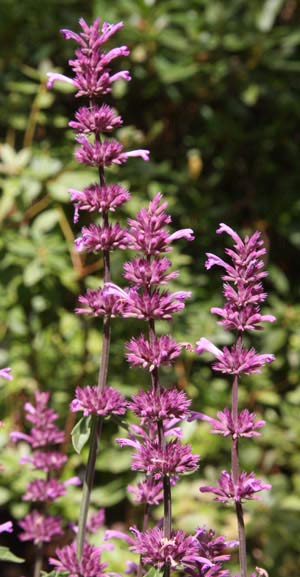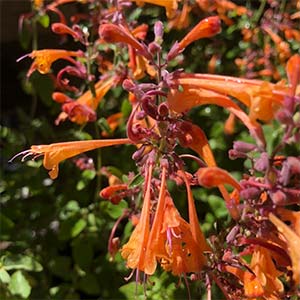
If you are looking for a long flowering perennial then Agastache are well worth considering. With over 30 species and many named varieties these are drought tolerant plant that are also great bird attracting plants and sometimes referred to as ‘Hummingbird Mint’ .
The foliage is fragrant when brushed, giving it another common name ‘Liquorice Mint’. So along with spiked blue to pink flowers and a fragrance that reminds of liquorice Agastache are a great plant for the garden border.
The flowers vary in form from species to species, colors range from blues through to orange red and pink.
One of the real attractions is that this a plant that attracts the bees and the birds, so its great for pollinators and therefore great for other plants as well.
Even in wet areas you can grow Agastache, you simply need to improve the drainage by hilling up the soil in the garden bed and planting them on the mounds.
Agastache Care
Regarded as hardy from USDA Zones 4 – 10 Agastache are widely grown.
Given a well drained soil and a sunny position Agastache require very little care. They are not even fussy about soil type, although they will perform a little better in reasonable soil.
Newly planted seedlings will require a little water through the firat summer, we suggest a little liquid seaweed fertilizer.
In the warmer zones Agastache can be lightly mulched in summer. In colder wetter zones it is best not to mulch at all in summer as this can cause some root problems.
Many gardeners in colder zones will mulch in winter with straw to protect from frosts and freezes.
TOP TIPS
- Ensure good drainage
- Do not over fertilize
- Do not over water
- Give plenty of sun
- Allow good air circulation
Pruning Agastache
Although they can look a little untidy in winter, it is best not to prune Agastache until you see the first signs of new growth in spring.
Cut out any dead or diseased stems first of all. Look for signs of new growth from the base of the plant and then cut back to this.
Agastache Varieties

One of our favourite species is Agastache pallidiflora ssp neomexica (see picture above). Lovely tall dusky pink flower spikes. However many others are also available for sale including.
- Agastache rupestris is a tall growing plant with pink flowers to 40″,
- Agastache ‘Ava’ has deep pink to red flowers and is a lower growing cultivar.
- Agastache aurantica ‘Apricot Sprite’ has apricot – peach flowers, a great plant for attracting birds. Flowers from late summer to fall and will reach around 30″ depending on conditions and cultivar.
- Agastache blue fortune.
All are popular perennial plants used widely in the garden border.
Agastache Propagation
You can collect seed and sow it into a cold frame in spring with good results.
Older clumps can also be divided in spring.\
- Simply dig with a fork, cut the foliage back by 1/3 or more, divide the clump and replant, watering in with a liquid seaweed fertiliser.
Agastache Plants are available for sale from the following nurseries
BLUESTONE PERENNIALSOffering a wide selection of bulbs, perennials, grasses, herbs trees and shrubs. Includes: Agastachewww.bluestoneperennials.com
DIGGING DOG NURSERY phone (707) 937-1130PO Box 471 Albion CA 95410 A spectacular selection of hard to find perennials, ornamental grasses, shrubs, trees and vines for your garden. Includes: Agastache auranthiaca, Agastache foeniculum, Agastache mexicana and others. www.diggingdog.com

